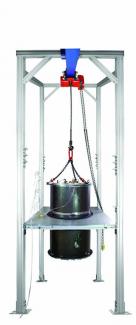A while back, Fellow Eric Cornell started thinking about all the waste heat produced by the use of water to cool refi neries and other industrial plants. In a few places, the waste hot water — at ~212°F — is used to heat commercial and apartment buildings. More often, though, such buildings are located too far from an industrial plant to make it cost effective to pipe the hot water to them. Instead, power plants and other facilities actually spend money to cool their hot water via cooling towers or ponds and then reuse the water — for more cooling.
What if there were an economical way to cool the waste water and get enough energy from it to make some electricity? All it might take, Cornell mused, would be to push 19th Century hotair engine technology to its limit. Of course, this sounds like a very different kind of research project for JILA. Consequently, Cornell has teamed up with Mechanical Engineering Professor Gary Pawlas and his students to bring his dream into reality.
“The idea is not complicated,” Cornell explained. “We run hot water through a heat exchanger (like a car radiator), where it heats air confi ned in a box. This keeps the volume the same, which means that as the air gets hotter, the pressure goes up. Then we let the air blast out to spin a turbine and make electricity.”
Because turbine technology is well developed, the key to Cornell’s vision for a 21st Century hot-air engine is the blast of air. It has to be produced carefully, effi ciently, cheaply — and sustainably. The prototype engine’s working fluid is air, its exhaust is air, and its heat source is hot water.
In fact, everything is nontoxic in the prototype engine, which is currently under development in Lab C229 by teams of undergraduate mechanical engineering students. Each academic year, a new group works on improving the performance of the engine, which sits inside a steel drum hung from a steel frame.
Cornell’s new hot-air engine sports one major improvement over its 19th Century counterpart: a moveable heat exchanger. The moveable heat exchanger moves up and down, forcing air through the device up into an air valve at the top of the steel drum, where it rushes out. This design makes it easy to run the engine and test it at different pressures, identify leaks, and crank fl ow rates up on demand. It clearly will play a central role in maximizing the power of the air blast sent out of the engine into a turbine.
With respect to the prototype, things appear to be progressing well. However, for the new engine to have commercial value, it must be able to produce at least 1 megawatt (MW) of power. That means building the engine inside a poured-concrete structure the size of an Olympic swimming pool — and making sure every aspect of the engine is running at its maximum possible efficiency.
“The jury’s out on whether this engine will work the way we want it to,” Cornell said. “It will defi nitely make electricity, but we’re not sure yet whether we can do it cheaply enough to be useful. And, even if it does work, it’s not going to be a game changer.”
What it may do is make life a little more comfortable for us humans as the global economy switches from its reliance on carbon-based fuels to renewable energy resources. As Cornell explained, “It’s worth a shot.” - Julie Phillips




